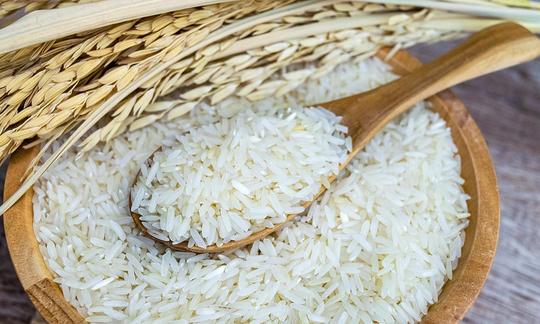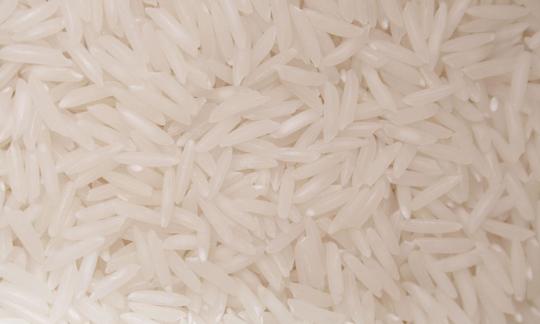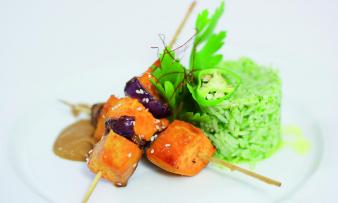Table of contents
Jasmine rice ( Siam rice , Thai rice , perfume rice or fragrant rice ) belongs to the fragrant rice varieties, as does basmati rice . Although jasmine rice is somewhat smaller, it is also a type of long-grain rice ( Oryza sativa subsp. indica ).
Use in the kitchen:
The cooking process gives jasmine rice the scent of a mixture of jasmine and popcorn. This rice is particularly popular in Thai cuisine thanks to its natural, floral-sweet aroma and mild taste. That's why it is also called perfume rice or Thai fragrant rice.
You can enjoy it pure, as fried rice or as a side dish with curries, soups, vegetable, fish or meat dishes. If you like its own taste, you can also prepare jasmine rice in salads or as a dessert (eg pudding). Raw perfumed rice is also used as flour in breads, flatbreads or it can be used to make gluten-free pasta.
What is the difference between jasmine rice and basmati rice? After cooking, both types of rice develop an aromatic scent. That is why the term fragrant rice is used for both types of rice, although it is much more common for jasmine rice. When cooked, jasmine rice sticks a little more than basmati rice. This property is valued in Thai cuisine because the rice sticks better to the chopsticks.
Jasmine rice is available as whole grain rice or as white, polished rice. With whole grain rice, the vitamins and minerals stay on the grain and make it more nutritious. This makes whole grain rice more filling than white rice and hunger does not return much later after a whole grain rice meal. If you want to benefit from the health advantages of brown rice but find its nutty taste too intense, you can also prepare the side dish rice with half brown and half white rice.
Preparing jasmine rice:
Before using, jasmine rice should be washed until the water is clear. This process washes away the rice dust from the white rice that sticks to it as a result of polishing. This means that the Siam rice is less sticky after cooking. If you prepare Thai rice without a rice cooker, the following rule of thumb applies: For 1 cup of rice, you need 2 cups of water. Bring the water to the boil and then simmer or steam the rice on a low heat with the lid closed for around 10 minutes so that the rice absorbs all the water. Remove from the heat, stir if necessary and leave to simmer for around 10 minutes with the lid closed.
If you soak the washed jasmine rice in water for about 10 minutes, you only need 1.5 times the amount of water to cook it. Whether you use salt water or not add any salt to the water is a matter of taste.
Steaming fragrant rice is also a popular option, as this brings out the aroma better. You can soak the rice before steaming. You can cook the rice particularly gently using a steamer, steamer insert or bamboo steamer. The rice absorbs the water through the steam. The ratio here is 1 cup of rice to 1.5 cups of water. Jasmine rice needs about 15-20 minutes at 100 °C.
Recipe for vegan yellow jasmine rice as a side dish:
You can flavor jasmine rice with various spices. If you refine the floral-smelling jasmine rice with a few saffron threads , it gives it a very special taste. If you don't have any saffron on hand, ready-made curry powder or ground turmeric in the jasmine rice will add a colorful and tasty change. Ginger , onions , garlic or chili also go well.
For more recipes with jasmine rice, see the link: " Recipes that make the most of this ingredient ".
| Not only vegans or vegetarians should read this: Vegans often eat unhealthily. Avoidable nutritional mistakes . |
Purchasing - where to buy?
The most expensive jasmine rice from Thailand is called "Golden" or "AAA" quality, it is sometimes also found under the name "Thai hom mali". Broken rice is broken rice and is comparatively cheap, but of inferior quality. 1
Only a few supermarkets or large retailers such as Coop , Migros , Rewe or Spar sell jasmine rice. Denner , Volg , Aldi , Lidl , Edeka , Hofer etc. do not usually offer the fragrant rice regularly in their range. You can also find wholegrain jasmine rice (wholemeal rice) in health food stores, organic shops, in retail stores or online. When buying jasmine rice, give preference to organic quality, as pesticides are often used in conventional cultivation. If possible, also pay attention to the origin.
Found in the wild:
There is no known wild form within the Oryza sativa species. Rice originally comes from the Oryza rufipogon species, but has undergone numerous breeding processes. All other Oryza species - except the cultivated plants Oryza sativa and Oryza glaberrima - are wild rice plants. Wild rice is also the name given to dark grains of the American grass genus Zizania . These plants are also known as water rice, but are not actually wild rice from a botanical point of view. 1
Storage:
Like all types of rice, jasmine rice should be stored in a dark, cool and, above all, dry place. White, peeled rice has a longer shelf life than whole grain rice because it does not have the silver skin and germ that encourage rancidity. Avoid storing it near strong-smelling foods such as coffee, spices, tea or chocolate, as the rice will otherwise take on their smell.
Cooked jasmine rice will keep in the fridge for 3-4 days. A positive aspect is that jasmine rice retains its taste and consistency better than other types of rice even after heating. If you have cooked too much, you should always let rice cool down quickly. Make sure that the temperature stays above 65 °C when heating. If the rice is not cooled properly and only heated slightly , Bacillus cereus pathogens can develop and multiply quickly. These bacteria can lead to severe vomiting and diarrhea. 2
Ingredients - nutritional value - calories:
How many calories does jasmine rice have? The energy content of jasmine rice is the same as that of long grain rice. The 365 kilocalories per 100 g come mainly from carbohydrates. The fiber content varies depending on whether you use white rice or whole grain rice. With 7% protein, jasmine rice has relatively little protein compared to basmati rice (9%) and other types of grain ( oats 17%, wheat 10%). There is hardly any fat.
When consuming 100 g of jasmine rice (and a daily requirement of around 2000 kcal), the manganese content makes up around 54% of the daily requirement. The content of 1.1 mg/100g can be compared with kidney beans and fresh basil . It is significantly higher than in basmati rice (0.7 mg). Selenium is present at 15 µg/100g, which covers around 27% of the daily requirement. Corn and rye have similar values. Only the Brazil nut stands out. Copper is also present in Thai fragrant rice, but we get enough of it anyway through our natural diet.
The content of pantothenic acid (vitamin B 5 ) sounds like a small amount at 1 mg/100g, but it is actually very high in comparison. Chanterelles , linseed , but also spelt and other types of rice contain a similar amount (basmati rice has a lower content of 0.63 mg). Pyridoxine (vitamin B 6 ) is present at 0.16 mg/100g, which can be compared with yellow bell peppers or ginger . 3 Basmati rice has much less pyridoxine (0.05 mg).
You can find all the ingredients, the coverage of the daily requirement and comparison values with other ingredients in our nutrient tables. In the article Nutrients explained you will get a detailed insight into the topic.
Health aspects - effects:
Rice is generally considered healthy because it contains hardly any fat and keeps you full for a long time. However, you should definitely choose wholegrain rice: peeled or polished (polished), i.e. white jasmine rice, has the healthy vital substances removed and the fiber content is also much lower. The outer layers also contain important secondary plant substances, such as phytic acid . On the one hand, phytic acid is said to bind minerals from food that are then no longer available to the human body, and on the other hand, it is said to have a strong antioxidant effect. Rice bran is usually a waste product from rice processing, but you can buy and use it in a similar way to wheat bran. The high fiber content has a positive effect on cancer prevention. 4
Jasmine rice does not contain gluten and is therefore, like all pure rice, gluten-free. When shopping, look for a gluten-free symbol (e.g. the crossed-out ear of corn) if you suffer from gluten intolerance or celiac disease.
Dangers - Intolerances - Side effects:
In general, white rice has a much higher glycemic index (GI) than whole grain rice, which leads to a more rapid increase in blood sugar levels. White jasmine rice has an even higher GI than white basmati rice due to its composition (ratio of amylose and amylopectin). 5
In some regions, the groundwater in rice-growing areas is heavily contaminated with arsenic or cadmium. The rice plant absorbs these toxins and accumulates them. Higher levels can be found in rice, rice cakes and rice flakes. Small children absorb arsenic more easily than adults, which is why children under 3 should not be given more than 20 g of rice cakes per week. 6
Folk medicine - natural healing:
A rice soup that has been proven in traditional Chinese medicine (TCM) is said to help with gastrointestinal complaints, allergies or kidney problems. In China, the soup is also eaten as a preventative measure, mainly for breakfast. It is eaten unsalted during a fast and also has a detoxifying and diuretic effect. 7 Rice is generally said to have a diuretic effect. Jasmine rice is also said to lower blood pressure. 8
Occurrence - Origin:
Where does jasmine rice come from? The origin of jasmine rice, or Siam rice or Thai rice, is almost certainly in northeastern Thailand, in the province of Yasothon. 8 Jasmine rice is also cultivated in Cambodia, Laos and southern Vietnam. 9 The following information helps to understand the name Siam rice: Until 1939, the country in Southeast Asia, which largely corresponds to today's Thailand, was called Siam. According to Wikipedia, in its heyday in the 19th century, it extended across Thailand, Cambodia and Laos as well as parts of Malaysia, Myanmar and Vietnam. Strictly speaking, Siam and Thailand are not synonyms.
Cultivation - Harvest:
Rice is not actually an aquatic plant. It is sown on dry soil. However, flooding protects the plants from pests and weeds.
When growing dry rice, a distinction is made between mountain rice cultivation and lowland rice cultivation (both rain-dependent). These methods are found in regions with little rainfall or in mountains with high humidity. Weed control is very labor-intensive and the yields are also lower than with water rice. The aroma is said to be very pronounced and it is sold at significantly higher prices. 1
There are deep-water or wet rice cultivation methods for water rice cultivation. Wet rice cultivation accounts for around 80% of the world harvest. However, the amount of water used is considerable: between 3,000 and 5,000 liters of running water are needed for 1 kg of rice. When managing water, care must be taken that water that flows too quickly washes the nutrients out of the soil and that water that flows too slowly causes algae to form. The labor intensity of wet rice cultivation is very high, but the yields are significantly higher than with dry rice cultivation. 1 Wet rice can be harvested 1-3 times a year, depending on the variety, type of cultivation and growing area. 13
When the rice panicles are brown, you can harvest them. Harvesting is done manually using a knife or mechanically using a special combine harvester. If the rice is harvested by hand, it is not threshed until a few days later. 11 After harvesting, the rice is dried and cleaned. In this form, the rice is called raw rice, unhusked rice or paddy rice. It still has the hard, woody and silicic husks and is still capable of germinating. Raw rice is used for sowing, but is not yet suitable for cooking. Half-raw rice (cargo or brown rice) is also known as natural or whole rice. This still has the germ and the silver skin, but no longer has the husks. White rice is milled rice sorted by size. This process removes the germ and the silver skin. 1
Another variant is parboiled rice. In the parboiling process, the air is removed from the raw rice in a vacuum container and then placed in lukewarm water. This dissolves the vitamins and minerals from the silver skin and the germ. These nutrients are then pressed into the interior of the rice grain using high pressure. Steam pressure is used to harden the rice starch on the surface of the grain so that the nutrients remain in the rice grain. Finally, the rice is dried. Only then are the husks removed from the treated raw rice. 1 Parboiled rice contains less fiber and less fat than wholegrain rice.
General information:
Rice is an annual grass species. There are many thousands of varieties of the Oryza sativa species. The most important belong to the subspecies Oryza sativa subsp. indica , which is characterized by long, narrow grains. Indica varieties grow mainly in the tropics and are not as sticky. Varieties of Oryza sativa subsp. japonica have oval to round grains and are very sticky (sticky rice). They are found mainly in subtropical areas. 10
Wikipedia: Gourmets differentiate between different types of rice and use them for different dishes. Arborio, Vialone or Carnaroli are preferred for risotto, basmati rice for Indian dishes, or jasmine rice for Thai dishes. In total, there are more than 120,000 types of rice worldwide.
The scent of Thai rice is nutty (like basmati rice) and is similar to that of the pandan palm ( Pandanus amaryllifolius ), a plant species in the screw pine family. The aroma comes from a chemical compound, 2-acetyl-1-pyrroline. 12
Rice straw is mainly used in Asia for shoes, hats or to make cheap rice paper. In Japan, the tatami mat is used as flooring in living rooms and temples.
Literature - Sources:











Comments